Sukhoi Su-33 Videos
|
Loading...
|
|
Sukhoi Su-33
Su-33
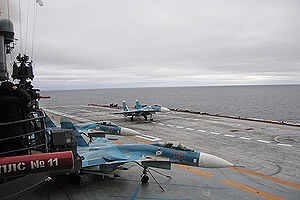
Picture - Su-33s on board Admiral Kuznetsov.
Role: Multirole fighter
Manufacturer: Sukhoi
First flight: May 1985
Introduction: 1994
Status: Operational
Primary user: Russian Naval Aviation
Number built: 24+
Unit cost: US$55 million (est.)
Developed from: Sukhoi Su-27
The Sukhoi Su-33 (NATO reporting name: Flanker-D) is a carrier-based multi-role fighter aircraft produced by Russian firm Sukhoi beginning in 1982. It is a derivative of the Su-27 ‘Flanker’ and was initially known as the Su-27K. The main differences from the Su-27 are that the Su-33 can operate from aircraft carriers and is capable of aerial refueling.
Design and development
Full scale design development of the Su-33 started in 1984 as T-10K, under Konstantin Marbashev. N.F. Sadovnikov was appointed the Design Bureau's chief test pilot for the programme. Conceptual design had passed critical design review by November 1984, with the detailed design finalized in 1985. The Su-33 first flew in May 1985.
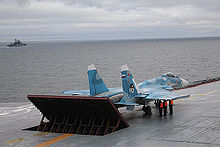
Picture - Su-33 being prepared for take-off on the Admiral Kuznetsov.
Unlike comparable American carrier-borne fighters like the F-14 Tomcat, the Su-33 uses a ski-jump instead of catapult for carrier takeoff. Using the ski-jump avoids the high catapult-induced loads, and provides the aircraft with a positive pitch and climb angle upon launch. However, when using a ski-jump, the Su-33 cannot launch at maximum takeoff weight.
The Su-33 sports canards that shorten the take-off distance and improve maneuverability, but required reshaping of the leading edge extensions. The canards counter pitch-down force generated by leading and trailing edge flaps reducing approach speed by a factor of 1.5; they also act as destabilizers in supersonic flight, by reducing pitch trim drag. The wing area was also increased, though the span remained unchanged. The wings were fitted with power-assisted folding, and the vertical tails were shortened to allow the fighter to fit in the typically crowded hangars of an aircraft carrier. The rear radome was shortened and reshaped to allow for the tail hook, as well as to save space inside the hangars. The IRST was moved to provide better downward visibility and an L-shaped retractable refuelling probe was fitted to increase range.
Mishap off Admiral Kuznetsov aircraft carrier
The Su-33 carries guided missiles such as the Kh-25MP, Kh-31 and Kh-41. The plane can be used in both night and day operations at sea. It can operate under assistance of the command center ship, or in conjunction with a Kamov Ka-31 (a variant of the Ka-27) early-warning helicopter. The R-27EM missiles provide it the capability to intercept antiship missiles.
Other than air defence, the duties of the Su-33 include destruction of enemy ASW, AWACS, and transport aircraft, anti-shipping strike, support of amphibious landing, escort, reconnaissance, and laying of minefields.
Operational history
Soviet Union and Russia
During testing, each pilot made 400 landings on a concrete runway matching the size, and shape of the carrier deck (the NITKA), in order to practice no-flare landing technique before making an actual landing on a carrier deck. Despite this, at one point a minor accident occurred during a touch-and-go. During a landing, the wind blew at 45 degrees to the port beam causing the prototype (then called T-10K), piloted by Victor Pugachev, to drift 3 m off course, nearly causing an accident. As the aircraft cleared the deck, a landing gear oleo struck several struts on the lower hull sponson. The struts buckled but the aircraft was undamaged. The pilots of both the MiG-29K ‘Fulcrum-D’ and Su-27K had all already seen the struts but did not complain about the placement because they were below flight deck level, their only objection being the turbulence generated by the sponson, which was later fixed.
The first actual carrier landing did not pass without incident, as would be hoped. It was discovered that despite the shortening of the fighter, it was still too tall to fit through the hangar door, and special clamps had to be fitted to the landing gear to squeeze it through the hangar.
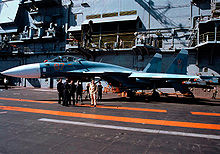
Picture - A Su-33 on board Admiral Kuznetsov
The next day, it was found prior to takeoff, that when the water cooled jet blast deflectors were set at their normal setting of 60 degrees, they were too close to the engine nozzles. They were ordered to be set at 45 degrees, but the actuator could not hold them in that position. The crew then improvised makeshift braces out of steel pipe to hold the deflector in position. Unfortunately, the welders neglected to clear the metal fragments that resulted from their work, and these fragments pelted observers. Then to make matters worse, the pop-up detents would not retract when ordered, and the prototype sat in front of the shield for 8 seconds longer than the maximum safe time of 6 seconds. This then caused the shield's water pipes to explode, blowing apart the shield. Some observers believed the fighters fuel lines had ruptured and ran, fearing an explosion. Viktor Pugachyov, who was piloting, was then ordered to throttle back his engines which resulted in the detents retracting, causing the fighter to jerk forward. Pugachev reacted quickly and stood on the brakes and shut off the engines. The fighter was towed to another position and Pugachev took off without using jet blast deflectors, or detents, climbed steeply, performed the Pugachev’s Cobra and flew away. From then on, a Kamov Ka-27PS search-and-rescue helicopter was flown close to the carrier in the event of an accident.
The Su-33 entered service in the Russian Navy in 1994. An air regiment comprising 24 fighters of the type was formed upon the Russian Navy’s only operating aircraft carrier, Admiral Kuznetsov. Russia currently operates 19 Su-33s, which need to be replaced by 2015. According to the newspaper "Bulletin Reports," the Russian Navy expects to buy the MiG-29K to replace Su-33 from 2011 to 2015. However the replacement will be probably postponed, because in Oct 2010 an upgraded Su-33 was tested.
Potential operators
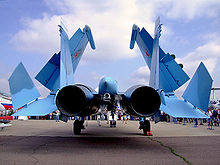
Picture - Su-33 at MAKS Airshow 2007.
The state-run company Rosoboronexport is finishing negotiations with the People’s Republic of China to ship up to 50 aircraft totalling US$2.5 billion. China would initially acquire 2 aircraft worth US$100 million for testing and then have further options to acquire an additional 12-48 aircraft. The fighters are intended to be used with the fledgling Chinese aircraft carrier program.
At the sixth Zhuhai Airshow in fall 2006, the first deputy director of the Military Technological Cooperation Bureau of Russian Federation, lieutenant general Aleksander Denisov of the Russian Air Force, publicly confirmed at the news conference that China had approached Russia for the possible purchase of Su-33, and negotiation was to start in 2007. The Xinhua News Agency subsequently published the information on its military website the same day (November 1, 2006) that China planned to "introduce Su-33". China had previously obtained a manufacturing license for Su-27 production.
An unnamed Russian official told UPI that the Chinese order for only seven aircraft was far too small to justify restarting the production line. Sukhoi is working on a more advanced version, the Su-33K, though technical details need to be worked out to integrate the advanced technologies of the Su-35 fighters into the Su-33 airframe.
China seems to have purchased an Su-33 prototype from Ukraine and is studying it to make a similar fighter, identified as the Shenyang J-15 by Russian military experts.
Modernisation
In 2010, Sukhoi developed a modernised version of the Su-33; flight trials began in October 2010.
Operators
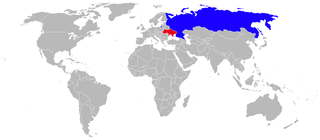
Picture - Sukhoi Su-33 Operators. Dark blue are current operators; red, former.
Russia
Russian Naval Aviation operates roughly between 24 and 36 Su-33s. 279th Shipborne Fighter Aviation Regiment is at Severomorsk-3 with the Northern Fleet, equipped with Su-25UTGs, and Su-33s. However these are being replaced by the MiG-29K as Russian primary Naval fighter.
Specifications (Su-33)
Data from KNAAPO Su-33 page, Sukhoi Su-30MK page, Gordon and Davison
General characteristics
Crew: 1
Length: 21.94 m (72 ft)
Wingspan: 14.70 m (48.25 ft)
Height: 5.93 m (19.5 ft)
Wing area: 62.0 m² (667 ft²)
Empty weight: 18,400 kg (40,600 lb)
Loaded weight: 29,940 kg (66,010 lb)
Max takeoff weight: 33,000 kg (72,750 lb)
Powerplant: 2x— AL-31F afterburning turbofans
Dry thrust: 7,600 kgf (74.5 kN, 16,750 lbf) each
Thrust with afterburner: 12,500 kgf (122.6 kN, 27,560 lbf) each
Wingspan, wings folded: 7.40 m (24.25 ft)
Performance
Maximum speed: Mach 2.17 (2,300 km/h, 1,430 mph) at 10,000 m (33,000 ft) altitude
Stall speed: 240 km/h (150 mp/h)
Range: 3,000 km (1,860 mi)
Service ceiling: 17,000 m (55,800 ft)
Rate of climb: 230md/ (45,350 ft/min)
Wing loading: 483 kg/m²; (98.9 lb/ft²)
Thrust/weight: 0.83
Maximum turn: +8 g (+78 m/s²)
Landing speed: 235-250 km/h (145-155 mph)
Armament
1 x— 30 mm GSh-30-1 cannon with 150 rounds
Up to 6,500 kg (14,300 lb) of munitions on twelve external hardpoints, including:
4 R-27 and 4R-73 air-to-air missiles
Various bombs and rockets
ECM pods
Related development
Sukhoi Su-27
Sukhoi Su-30
Sukhoi Su-34
Sukhoi Su-35
Sukhoi Su-37
Comparable aircraft
Eurofighter Typhoon
Dassault Rafale
F/A-18E/F Super Hornet
F-15 Eagle
F-14 Tomcat
Mikoyan MiG-29K
Shenyang J-15
Bibliography
Gordon, Yefim and Peter Davison. Sukhoi Su-27 Flanker, Specialty Press, 2006. ISBN 1-58007-091-4.
Living Warbirds: The best warbirds DVD series.
Source: WikiPedia